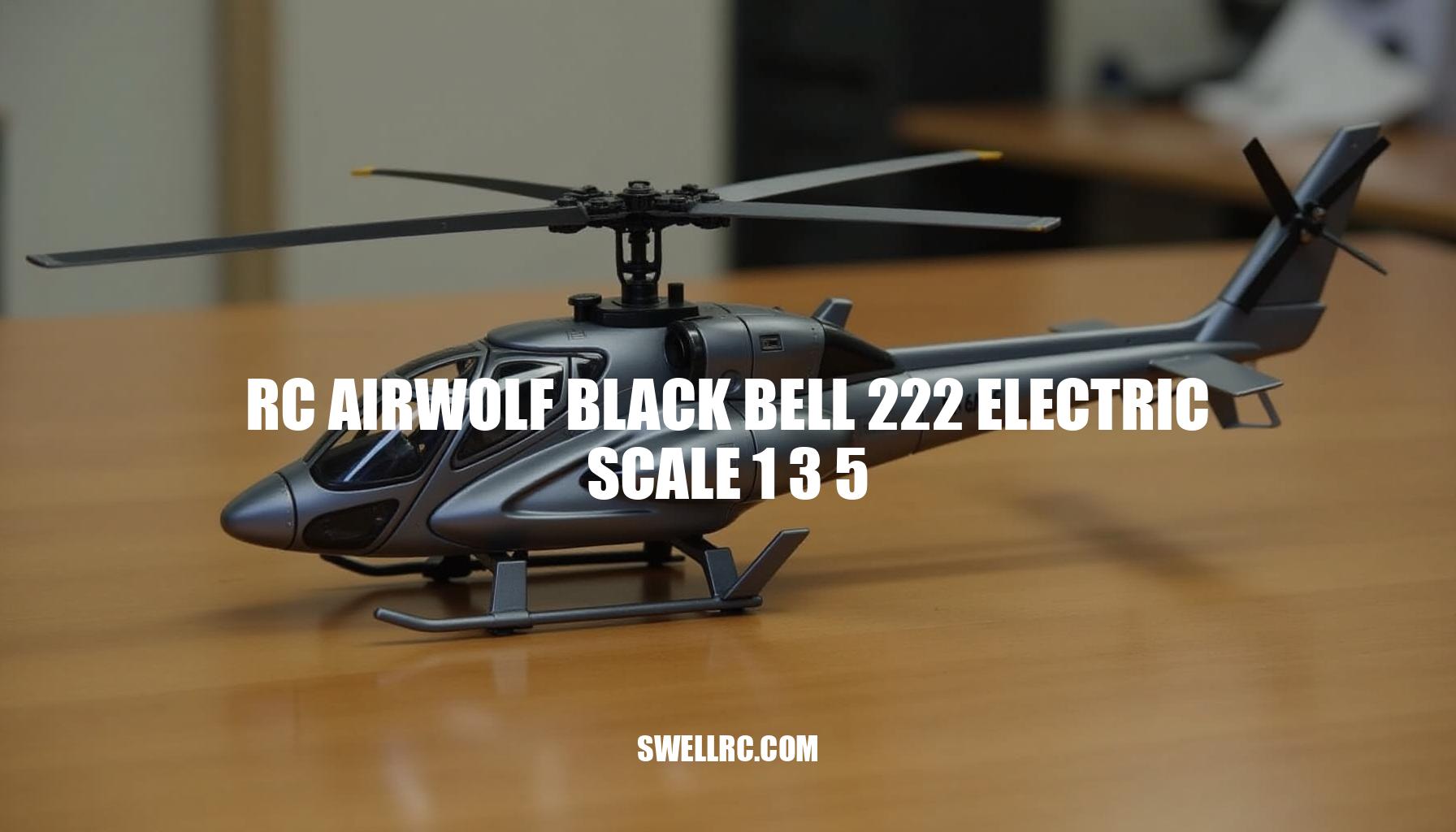RC Airwolf Black Bell 222 Electric Scale 1:3.5 Review
The first time I saw the RC Airwolf Black Bell 222 Electric Scale 1:3.5 taxi out of the pits, I felt that instant rush you only get from true scale masterpieces. The presence, the silhouette, and the way the fuselage reflected the morning light—this was the model aircraft that pulled me deep into the world of large-scale helicopter models. If you’re an RC hobbyist who’s ever wondered what a screen legend might look and feel like in RC form, this Airwolf RC helicopter is it.
The Airwolf theme may be cinematic, but the engineering behind this electric scale helicopter is very real: a meticulously molded Bell 222 RC scale model fuselage, an electric power system sized for confident authority, and a 1:3.5 scale that delivers museum-grade detail with field-ready performance. This electric RC Bell 222 offers not just visual appeal but the dynamic flying characteristics true to its rotorcraft heritage. For enthusiasts of scale RC models searching for a detailed scale replica, this model sets a new benchmark in quality and authenticity.
The Legacy of the Airwolf and Bell 222: A Design Born for Screen and Sky
Before Airwolf became a pop-culture icon, the Bell 222 was already admired for its elegant lines and business-class capability. Those same sweeping curves and tidy proportions are why the Bell 222 RC scale model translates so beautifully into RC form—the fuselage just looks right in the air. Airwolf layered a cinematic edge onto that proven design, adding an unmistakable presence that RC scale model builders have chased for decades.
If you’re curious why this airframe commands so much respect in the hobby, the background and featured builds at SwellRC show exactly how the electric RC Bell 222 became the perfect canvas for Airwolf-inspired detail.
From the sleek fuselage to the detailed rotorcraft components, this Airwolf RC helicopter captures the essence of the original model while offering enthusiasts a highly accurate and enjoyable flying experience.
- Rotors and mechanics: Precision in the rotor scale helicopter design allows for realistic flight performance.
- Detailed scale replica features: Intricate decals, paint schemes, and cabin details elevate the authenticity.
- Scale RC models community: Builders and pilots admire and share techniques for perfecting the Airwolf look.
- Electric motors and controls: Modern electric RC Bell 222 variants provide smooth handling and reliable power.
Embracing both the legacy of the Bell 222 and the cultural impact of Airwolf, this RC helicopter remains a cherished piece for hobbyists who value both style and substance in their scale RC models.
Engineering Brilliance: Technical Breakdown of the 1:3.5 Scale Electric Helicopter
After assembling and trimming my setup, what struck me most was how the engineering choices show up in flight. Big airframes demand stiff structures and smooth power—this electric scale helicopter delivers both. The composite fuselage rides on a carbon or alloy internal frame that keeps vibrations in check, while a high-voltage brushed power system supplies the torque and head speed consistency that large-scale RC helicopter performance requires.
A modern flybarless stabilization controller ties it together, giving the feel of a heavy, stable rotorcraft that still tracks with precision.
| Specification | Details |
|---|---|
| Scale Ratio | 1:3.5 (typical Bell 222-class build) |
| Approx Rotor Diameter | ~3.2 m (about 126 in) |
| Approx Fuselage Length | ~3.7 m (about 146 in) |
| Structure | Composite fuselage over carbon fiber and aluminum internal frames |
| Power System | High-power brushless motor with HV ESC |
| Battery | 12S–16S LiPo, typically 10000–20000 mAh+ packs (often in parallel) |
| Servos | HV metal-gear cyclic and tail servos, ensuring top servo quality |
| Stabilization | Flybarless unit with 3-axis gyro and integrated governor |
| All-up Weight | Typically in the tens of kilograms (setup-dependent) |
The rotor scale helicopter benefits greatly from tight linkages combined with superior servo quality to achieve unmatched control precision. The flybarless unit’s governor locks the head speed, resulting in steady, predictable transitions essential for heavy, large-scale helicopter models. If you’re sizing your project or comparing classes, the comprehensive guide at RC helicopter sizes explained is an excellent resource.
For broader product discovery and scale inspirations, browse categories like rotor scale helicopters to see how different manufacturers approach large-scale detailing and mechanics, combining top-tier components such as brushless motors, HV ESCs, and carbon fiber frames to elevate the flying experience.
Flying Experience: What It’s Like to Pilot the Airwolf 1:3.5
Spooling up the Airwolf RC helicopter is more than just powering on; it’s a meticulous ritual. With batteries charged and the FBL system initialized, the entire flying experience begins as the system hums to life—a deep electric whir that resonates even through your shoes. As the main blades engage, the fuselage lifts with a calm but decisive poise, showcasing exceptional hover stability.
In this silent suspension, the helicopter responds to every micro input with a precision that speaks to superior RC helicopter handling.
Once you push forward, the sleek design of the Airwolf shines in forward flight. Its long tail boom and aerodynamically sculpted fairings help stabilize the craft, creating a seamless blend of control and style. The rotor motion thickens audibly as the rotor disk loads, amplifying the immersive sensation of slicing through the air.
Navigating with LED navigation and landing lights, dusk flights become cinematic, as the LED systems punctuate the Airwolf’s presence like a real aircraft working an authentic pattern.
What impressed me most was the helicopter’s adept inertia management—planning your lines translates directly into graceful, deliberate motion. When compared to other large-scale helicopter models like the Boeing CH-47 Chinook or the tandem-rotor platforms, the Airwolf demonstrates a more streamlined executive feel: less sail area, sharper arrow-like precision. Against utility models such as the UH-60 Blackhawk, the Airwolf maintains stability but adds a flair of showtime flair each time it banks past onlookers, embodying the perfect harmony of performance and style.
Practical Considerations: Pricing, Upgrades, and Accessibility
Before purchasing an RC helicopter body kit, it’s essential to understand the pricing variations, which depend largely on the kit type, underlying electronics, and the level of scale detail you want. Large scale models, for instance, reward careful budgeting and thoughtful component selection to maximize the benefits. Popular upgrades and options that enthusiasts frequently choose include:
- Power: opting for higher-capacity 12S–16S packs, premium HV ESCs (Electronic Speed Controllers), and fine-tuned governors to boost performance with efficient brushless motor systems.
- Scale detail: enhancing realism through upgraded lighting kits, detailed cockpit interiors, and functional doors that bring your model to life.
- Mechanics: incorporating precision tail gearboxes, durable metal head components, and quiet belt drives for smoother, more reliable operation.
- Avionics: installing pro-grade FBL (flybarless) controllers and telemetry systems to monitor voltage and RPM in real-time.
From my personal assembly experience, this project typically spans multiple evenings. It’s best to dry-fit all components before final epoxy application to ensure precision. Essential assembly tools include metric hex drivers, a torque driver, CA and epoxy adhesives, heat-shrink tubing, and thread locker to secure fasteners.
For a robust radio setup, consider an 8+ channel transmitter to manage lighting, retracts, and other functions. A separate BEC or dual-power bus is recommended to provide clean, stable power across all systems. Field gear like a parallel charge board, a balance charger featuring an IR readout, and a wattmeter can greatly simplify battery management and performance monitoring.
If you’re navigating through different scale RC models before making a final choice, you might appreciate the classic elegance of the RC Bell 47 or the imposing transport presence of the Avios C-130 RC plane. Both offer unique perspectives on how size, design layout, and intended mission profile shape your overall flying experience.
Comparison and Insights: Understanding Scale Relationships
Scale changes everything—cost, realism, presence, and even your preflight checklist. Here’s a quick look at how the 1:3.5 class stacks up for a Bell 222-based model (approximations using Bell 222 real-world dimensions: rotor ~11.3 m, length ~13.1 m):
| Scale | Rotor Diameter | Length | Characteristics |
|---|---|---|---|
| 1:3.5 | ~3.23 m | ~3.74 m | Show-stopping presence; highest cost and transport needs; superb stability and flight realism |
| 1:4 | ~2.82 m | ~3.28 m | Still very large; slightly easier logistics |
| 1:6 | ~1.88 m | ~2.18 m | Easier to store and transport; lower consumables cost; more wind-sensitive |
| 1:10 | ~1.13 m | ~1.31 m | Backyard-capable, budget-friendly, but sacrifices some scale detail and inertia |
Bigger airframes fly “heavier” in a good way—providing smoother tracking and more authority in wind—while smaller ones offer convenience and forgiveness at the workbench. This balance of RC helicopter sizes and scale RC models greatly affects maintenance demands and the cost vs size equation.
The craftsmanship involved also scales accordingly. At 1:3.5 scale, you can justify museum-grade details and functional features, embracing a true large-scale helicopter model experience. At 1:6, the focus shifts more to finish quality and reliable mechanics designed for frequent weekend flying sessions.
Understanding these nuances is key to matching your expectations for flight realism, maintenance, and transport, tying back to the underlying logic of helicopter sizing principles and classes.
Conclusion: Why the RC Airwolf Black Bell 222 Stands Above Others
After months of meticulous research, careful assembly, and numerous flights, I can confidently say the Airwolf RC helicopter built on the Bell 222 RC scale model platform delivers an exceptional experience. This rotorcraft offers scale precision rarely found in models of its size, capturing the essence and presence of a real aircraft at a 1:3.5 scale. The integration of an advanced electric system ensures electric efficiency, providing clean, consistent power for every flight session.
The design elegance of this model turns heads at every takeoff, making it not just an aircraft but a statement piece. SwellRC’s comprehensive range of components and thorough documentation streamlined the entire process, from conceptual planning to the maiden flight. For any dedicated RC hobbyist, this rotorcraft combines precision engineering and aesthetic appeal seamlessly, elevating the RC flying experience.
- Scale Precision: Accurate detailing that mirrors the real Bell 222 helicopter.
- Electric Efficiency: Reliable and clean power delivery for smooth flight operations.
- Design Elegance: Eye-catching styling that captures attention and compliments function.
- Airwolf RC Helicopter: A unique platform merging iconic design with modern RC technology.
- RC Hobbyist Favorite: Offers an immersive flying experience beyond typical rotorcraft models.
After countless flights, this model proves it’s much more than just an RC helicopter – it’s a complete experience that blends artistry and technology on every level.
Frequently Asked Questions
- What makes the RC Airwolf Black Bell 222 unique among scale RC helicopters?
Its fusion of the Bell 222’s timeless lines with Airwolf-inspired detailing, combined with a large 1:3.5 scale and a high-power electric drivetrain, creates rare visual presence and smooth, confident flight performance that stands out on any flight line. - How large is a 1:3.5 scale helicopter in comparison to a real Bell 222?
Using approximate Bell 222 dimensions (rotor ~11.3 m, length ~13.1 m), a 1:3.5 scale model spans roughly a 3.23 m rotor and about 3.74 m in length—truly a showpiece size that demands careful transport and setup. - Is the Airwolf Black Bell 222 suitable for beginners or only experienced pilots?
It’s best for experienced pilots or beginners working closely with a mentor. Large-scale models require advanced setup skills, meticulous preflight habits, and proficient hovering and orientation control. - What materials are used in the Airwolf Black Bell 222 model construction?
Typically a composite (fiberglass or carbon-reinforced) fuselage over carbon or aluminum internal frames, with metal head components, HV servos, and a brushless power system managed by a flybarless controller. - How realistic are the flight characteristics of this scale RC helicopter?
Very realistic for its class. The mass and rotor disk size produce smooth tracking, stable hovering, and cinematic forward flight, especially with a well-tuned governor and quality servos. - How does the Airwolf compare to other large-scale RC helicopters like the Boeing CH-47 Chinook or UH-60 Blackhawk?
Compared with tandem-rotor Chinooks, the Airwolf’s single-rotor Bell 222 platform feels more precise and streamlined. Against a UH-60-style utility build, the Airwolf trades rugged utility vibes for executive sleekness and showmanship, while maintaining strong stability. - What are the maintenance and upgrade options available for this helicopter?
Common upgrades include higher-capacity HV batteries, premium ESCs, advanced FBL units, lighting and cockpit detail kits, and metal head/tail components. Maintenance focuses on bolt checks, vibration control, battery health, and periodic drivetrain inspection.



